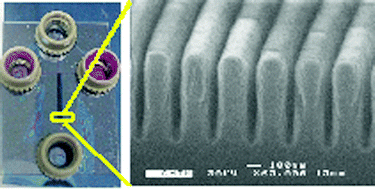This report presents a study of electrokinetic transport in a series of integrated macro- to nano-fluidic chips that allow for controlled injection of molecular mixtures into high-density arrays of nanochannels. The high-aspect-ratio nanochannels were fabricated on a Si wafer using interferometric lithography and standard semiconductor industry processes, and are capped with a transparent Pyrex cover slip to allow for experimental observations. Confocal laser scanning microscopy was used to examine the electrokinetic transport of a negatively charged dye (Alexa 488) and a neutral dye (rhodamine B) within nanochannels that varied in width from 35 to 200 nm with electric field strengths equal to or below 2000 V m−1. In the negatively charged channels, nanoconfinement and interactions between the respective solutes and channel walls give rise to higher electroosmotic velocities for the negatively charged dye than for the neutral dye, towards the negative electrode, resulting in an anomalous separation that occurs over a relatively short distance (<1 mm). Increasing the channel widths leads to a switch in the electroosmotic transport behavior observed in microscale channels, where neutral molecules move faster because the negatively charged molecules are slowed by the electrophoretic drag. Thus a clear distinction between “nano-” and “microfluidic” regimes is established. We present an analytical model that accounts for the electrokinetic transport and adsorption (of the neutral dye) at the channel walls, and is in good agreement with the experimental data. The observed effects have potential for use in new nano-separation technologies.

You have access to this article
 Please wait while we load your content...
Something went wrong. Try again?
Please wait while we load your content...
Something went wrong. Try again?


 Please wait while we load your content...
Please wait while we load your content...